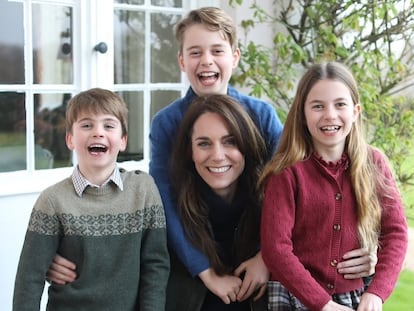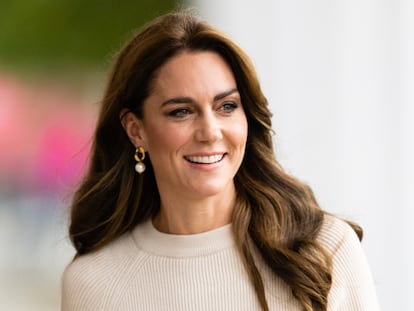Manipulation of Kate Middleton’s photo sparks credibility crisis in the British monarchy
The Princess of Wales’ apology for editing the image that sought to silence rumors about her absence is a sign that the royal family was unable to control the scandal

“Warts and all.” It’s a phrase that has become an indelible part of the British vernacular. Oliver Cromwell — the politician who imposed a republic in monarchical England for 11 short years — tasked Samuel Cooper with painting a portrait that would include all his facial imperfections. And the artist did not falter. Since then, the expression has been synonymous with an honest attitude, of prioritizing the truth. Kate Middleton, the Princess of Wales, wanted to an edit a photo aimed at silencing the rumors and speculation about her health, and ended up plunging the British royal family into a credibility crisis that it is struggling to come out of.
“This isn’t anything new,” royal expert Richard Fitzwilliams told METRO, pointing out that historically, prominent figures could “hide under the cloak of the artist’s skill.” “But if you are involved in these, shall we say, ambiguities of behavior, don’t get caught. It doesn’t look good and it doesn’t help your image. I think in the future they will make sure that this sort of touching up or manipulation [...] does not happen because it damages your credibility.”
The British media had given the Princess of Wales considerable space in recent months. Partly as a result of the collective lesson from the tabloid press’ harassment of Lady Di; partly as a result of the legal cases some tabloids had lost in their battle against Prince Henry; and partly as a result of Kate Middleton’s popularity among the British, the media had respected the Kensington Palace’s request for privacy when it announced in mid-January that the princess had undergone “abdominal surgery” — without giving more details — and that she would not return to royal duties until after Easter (in mid-April).
Even when the American gossip website TMZ released an unauthorized photo of Middleton, sitting in the passenger seat of an Audi 4x4 driven by her mother around Windsor, no British media outlet decided to publish it. Such a decision was unprecedented in a country where the press had published an image of the Duchess of York Sarah Ferguson’s lover licking her big toe in the pool of a hotel in Saint-Tropez and the famous kiss between Lady Di and Dodi Al-Fayed on board a yacht in the Mediterranean.
“It’s a lesson in how to turn success into immediate failure. It is very serious, because if you compromise truth, credibility goes with it,” said Michael Cole, the BBC’s former royal expert told the conservative network GB News. “[News agencies] have people who look at images from war zones, from Gaza, from Ukraine, they have to swap fakes because there are people out there [...] peddling propaganda. To think that they thought that they could get a dodgy image past these experts was totally insane. It does undercut the credibility of the royal family,” he said. “The importance cannot be exaggerated.”
The Princess of Wales has been sharing photos of her children and family events with the media for years. She is a photography enthusiast who discovered a simple and effective way to control the paparazzi and protect her privacy. Her children have not had to suffer the harassment that her husband, Prince William, and his brother, Prince Harry have been subjected to.
Until now, the arrangement had worked. The leading news agencies — the same ones that pulled the princess’s photo citing manipulation concerns — had no problem with distributing the photos supplied by Kensington Palace, the official residence and name given to the office handling the affairs of the Prince and Princess of Wales. They were innocent photos used to mark significant dates or send holiday greetings. That said, there had been some warning signs. For example, last Christmas, in a black-and-white family photo, Prince Louis’ little finger had mysteriously disappeared, and there was a third chair behind the chair in which Princess Charlotte was sitting.
The Christmas portrait sparked a flood of jokes on social media. But with Kate Middleton’s photo on Sunday — which many saw as a kind of “proof of life” following weeks of wild rumors about her health and whereabouts — the problem became so big, Kensington Palace could not contain it. The Princess of Wales had to apologize hours later, and acknowledge that she had edited the image.
To justify her numerous public acts, Queen Elizabeth II once claimed that “people had to see her to believe in her.” Middleton has learned, the hard way, that in the age of artificial intelligence and filters, it is no longer enough to be seen. People have to believe that what they see is true.
Sign up for our weekly newsletter to get more English-language news coverage from EL PAÍS USA Edition
Tu suscripción se está usando en otro dispositivo
¿Quieres añadir otro usuario a tu suscripción?
Si continúas leyendo en este dispositivo, no se podrá leer en el otro.
FlechaTu suscripción se está usando en otro dispositivo y solo puedes acceder a EL PAÍS desde un dispositivo a la vez.
Si quieres compartir tu cuenta, cambia tu suscripción a la modalidad Premium, así podrás añadir otro usuario. Cada uno accederá con su propia cuenta de email, lo que os permitirá personalizar vuestra experiencia en EL PAÍS.
¿Tienes una suscripción de empresa? Accede aquí para contratar más cuentas.
En el caso de no saber quién está usando tu cuenta, te recomendamos cambiar tu contraseña aquí.
Si decides continuar compartiendo tu cuenta, este mensaje se mostrará en tu dispositivo y en el de la otra persona que está usando tu cuenta de forma indefinida, afectando a tu experiencia de lectura. Puedes consultar aquí los términos y condiciones de la suscripción digital.
More information
Archived In
Últimas noticias
Most viewed
- Reinhard Genzel, Nobel laureate in physics: ‘One-minute videos will never give you the truth’
- Oona Chaplin: ‘I told James Cameron that I was living in a treehouse and starting a permaculture project with a friend’
- Pablo Escobar’s hippos: A serious environmental problem, 40 years on
- Why we lost the habit of sleeping in two segments and how that changed our sense of time
- Charles Dubouloz, mountaineering star, retires at 36 with a farewell tour inspired by Walter Bonatti











































